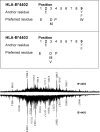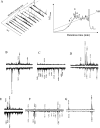A naturally selected dimorphism within the HLA-B44 supertype alters class I structure, peptide repertoire, and T cell recognition
- PMID: 12939341
- PMCID: PMC2194191
- DOI: 10.1084/jem.20030066
A naturally selected dimorphism within the HLA-B44 supertype alters class I structure, peptide repertoire, and T cell recognition
Abstract
HLA-B*4402 and B*4403 are naturally occurring MHC class I alleles that are both found at a high frequency in all human populations, and yet they only differ by one residue on the alpha2 helix (B*4402 Asp156-->B*4403 Leu156). CTLs discriminate between HLA-B*4402 and B*4403, and these allotypes stimulate strong mutual allogeneic responses reflecting their known barrier to hemopoeitic stem cell transplantation. Although HLA-B*4402 and B*4403 share >95% of their peptide repertoire, B*4403 presents more unique peptides than B*4402, consistent with the stronger T cell alloreactivity observed toward B*4403 compared with B*4402. Crystal structures of B*4402 and B*4403 show how the polymorphism at position 156 is completely buried and yet alters both the peptide and the heavy chain conformation, relaxing ligand selection by B*4403 compared with B*4402. Thus, the polymorphism between HLA-B*4402 and B*4403 modifies both peptide repertoire and T cell recognition, and is reflected in the paradoxically powerful alloreactivity that occurs across this "minimal" mismatch. The findings suggest that these closely related class I genes are maintained in diverse human populations through their differential impact on the selection of peptide ligands and the T cell repertoire.
Figures







Similar articles
-
Identification of the peptide binding motif for HLA-B44, one of the most common HLA-B alleles in the Caucasian population.Biochemistry. 1995 Aug 15;34(32):10130-8. doi: 10.1021/bi00032a005. Biochemistry. 1995. PMID: 7543776
-
Differences in the recognition by CTL of peptides presented by the HLA-B*4402 and the HLA-B*4403 molecules which differ by a single amino acid.Tissue Antigens. 1999 Feb;53(2):111-21. doi: 10.1034/j.1399-0039.1999.530201.x. Tissue Antigens. 1999. PMID: 10090611
-
The impact of human leukocyte antigen (HLA) micropolymorphism on ligand specificity within the HLA-B*41 allotypic family.Haematologica. 2011 Jan;96(1):110-8. doi: 10.3324/haematol.2010.030924. Epub 2010 Oct 7. Haematologica. 2011. PMID: 20934997 Free PMC article.
-
Characterization of natural peptide ligands for HLA-B*4402 and -B*4403: implications for peptide involvement in allorecognition of a single amino acid change in the HLA-B44 heavy chain.Tissue Antigens. 1994 Nov;44(5):311-7. doi: 10.1111/j.1399-0039.1994.tb02401.x. Tissue Antigens. 1994. PMID: 7878657
-
HLA class I-associated diseases with a suspected autoimmune etiology: HLA-B27 subtypes as a model system.Eur J Cell Biol. 2012 Apr;91(4):274-86. doi: 10.1016/j.ejcb.2011.03.003. Epub 2011 Jun 12. Eur J Cell Biol. 2012. PMID: 21665321 Review.
Cited by
-
Understanding the complexity and malleability of T-cell recognition.Immunol Cell Biol. 2015 May-Jun;93(5):433-41. doi: 10.1038/icb.2014.112. Epub 2015 Jan 13. Immunol Cell Biol. 2015. PMID: 25582337 Review.
-
Peptide-binding motif of HLA-A*6603.Immunogenetics. 2005 Jan;56(10):769-72. doi: 10.1007/s00251-004-0747-1. Epub 2004 Dec 8. Immunogenetics. 2005. PMID: 15592665
-
A shared epitope of the interphotoreceptor retinoid-binding protein recognized by the CD4+ and CD8+ autoreactive T cells.J Immunol. 2005 Aug 1;175(3):1851-7. doi: 10.4049/jimmunol.175.3.1851. J Immunol. 2005. PMID: 16034128 Free PMC article.
-
Increased diversity of the HLA-B40 ligandome by the presentation of peptides phosphorylated at their main anchor residue.Mol Cell Proteomics. 2014 Feb;13(2):462-74. doi: 10.1074/mcp.M113.034314. Epub 2013 Dec 23. Mol Cell Proteomics. 2014. PMID: 24366607 Free PMC article.
-
Distinct assembly profiles of HLA-B molecules.J Immunol. 2014 Jun 1;192(11):4967-76. doi: 10.4049/jimmunol.1301670. Epub 2014 Apr 30. J Immunol. 2014. PMID: 24790147 Free PMC article.
References
-
- Hill, A.V., C.E. Allsopp, D. Kwiatkowski, N.M. Anstey, P. Twumasi, P.A. Rowe, S. Bennett, D. Brewster, A.J. McMichael, and B.M. Greenwood. 1991. Common west African HLA antigens are associated with protection from severe malaria. Nature. 352:595–600. - PubMed
-
- Parham, P., and T. Ohta. 1996. Population biology of antigen presentation by MHC class I molecules. Science. 272:67–74. - PubMed
-
- Messaoudi, I., J.A. Patino, R. Dyall, J. LeMaoult, and J. Nikolich-Zugich. 2002. Direct link between MHC polymorphism, T cell avidity, and diversity in immune defense. Science. 298:1797–1800. - PubMed
-
- Marsh, S.G., P. Parham, and L.D. Barber. 2000. The HLA Facts Book. Academic Press, London. 398 pp.
-
- Sette, A., and J. Sidney. 1999. Nine major HLA class I supertypes account for the vast preponderance of HLA-A and -B polymorphism. Immunogenetics. 50:201–212. - PubMed
Publication types
MeSH terms
Substances
Grants and funding
LinkOut - more resources
Full Text Sources
Other Literature Sources
Molecular Biology Databases
Research Materials

